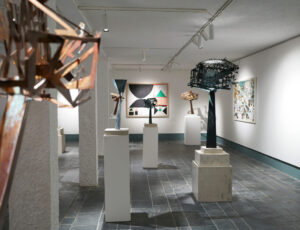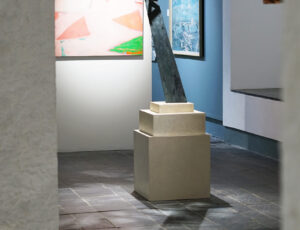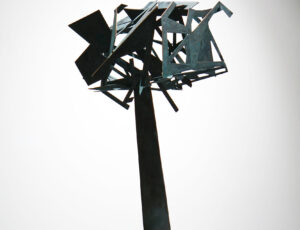16th June 2023 - 15th July 2023
Preview: Friday 16th June 17:30 onwards, all welcome!
The Show | Tom Leaper
Renowned Penwith sculptor Tom Leaper has extended the idea of the thorn trees made in lockdown into a full exhibition of open-structured compositions built out of fragments of bronze sheets, woven together to create a series of works based on Cornish woodlands; angular, windswept, inspired by the landscape of Penwith.
Invited into the space to celebrate Tom’s 60th year are artists Sophie Fraser, Jason Lilley, Karen McEndoo, Immi Rorke and Iona Sanders. Each has contributed paintings to compliment and harmonise with the angular forms of the sculptures.
Tom Leaper
“I’ve lived and worked on the edge of the Moors in West Penwith for almost 40 years and feel deeply rooted in its landscape and the community here. My work involves private commissions alongside my studio practice, resulting in artwork that ranges in both form and media. The scale of my work also varies, from intimate painting and sculpture to large installations, fountains, landscape design, and public projects. I enjoy great creative freedom this way.
Over the years I’ve become a skilled metalworker, using sheet bronze, stainless steel and copper as well as solid casting in bronze and iron. I’ve embraced cutting-edge design processes to enhance my traditional fabrication techniques. These include the use of fibreglass, vacuum moulding, drone site-mapping and AutoCAD design. Often I will model a sculpture in clay, then 3D-scan it to be digitally enlarged and milled in high density foam, before being cast in metal at a larger size. This allows me to retain the unique qualities of hand-formed sculpture at an impressive scale.
I’m drawn to organic forms, they’re calming to look upon, and incredibly absorbing to make. I hope those engaging with my work similarly have a pleasant, thoughtful experience.
I’m fascinated with the process of abstraction. You can start with a representational subject and simplify it, break it down into its formal elements. I prefer to start with the unrecognisable form, and build it up, working until I get a sense of something, a hint of what it ‘is’.”
– Tom Leaper
–
Sophie Fraser was born in Canterbury, Kent in 1992 and grew up in West Cornwall where she has lived since. Her work surrounds ideas of the ever-changing landscape, full of strong colour and textural echoes. Working outdoors as well as in the studio; sketches, photographs, memory, and intuition are key within the development of her paintings. This evokes a sense of the landscape and the connections she feels within it in a semi-abstract manner.
“My work explores my relationship with the landscape. The aim is to capture my initial reaction to a scene and harness that feeling of energy. Something draws me into the landscape, and I want to capture my own connection with the dynamic surroundings. I wish to compel viewers into thinking about what a piece says to them, and induce their own, new relationship with the chosen subject.
I’ve always immersed myself in art, ever since I was little I’ve been fascinated with creating work and my own style. When I was about four I remember an artist asking me ‘would you like to be an artist when you grow up?’. I answered ‘I am an artist’ whilst submerged in several paintings. When creating a piece of art I feel a sense of natural purpose, and bringing something to the world that others might connect with in an individual, personal way, makes me feel alive.”
– Sophie Fraser
scfraser@outlook.com
–
Jason Lilley
“Jason Lilley could be referred to as a “fourth generation neo romantic” in his return to a late 40s style of depiction. His new works observe and record the inner life of of the north coast, West Penwith landscape, of everything that grows, wriggles, walks crawls and flies its unique Stone and Bronze Age land.
Using a limited colour palette Lilley has evolved a way of sewing the whole painting together using an intestinal, meandering, glyphic, graphic line language. The whole evokes the life, in visual marks, of the sensory experience of driving and walking the West Penwith moors.
After Peter Lanyon’s contribution to this subject, in the 1950s, it could not have been an easy task to create a personal, symbolic language at this late stage, in the “painting games” evolution. Yet he has forged a style that gives us a new way of reading, through the experience of his paintings, a new referent for when we next go and experience this beautiful ancient area of Cornwall.”
- Clark Rickard.
–
Karen McEndoo was born in Carshalton in Surrey very soon after the family moved to Ghana, amongst others in Africa which has had a tremendous influence on her work, inspired particularly by the rich colours, wood carvings and the music.
She originally trained as a graphic designer/illustrator but over time her work has more expressive, finding inspiration in the St Ives Group of artists from the mid twentieth century and has been a regular visitor to the St Ives Society of Artists gallery since the 1990s.
Science and nature are huge influences and she is an avid lover of wildlife. With the art jeweller Sarah Drew Karen founded Terramaterart a group of like-minded women artists whose fundamental aim is to herald the protection of nature Through their art the group present a world full of beauty and fragility and invite onlookers to review their place and their duty to be kind to our planet.
Karen is a full member of:
The Penwith Gallery
St Ives Society of Artists
National Acrylic Painters Association among others
Working Methods:
“Many artists find the idea of a blank canvas daunting and I am no exception. My first task is to break the whiteness by putting down a base colour which, because of the nature of my work, shines through and becomes an intrinsic part, uniting the picture as a whole.I tend not to plan my paintings preferring instead to allow my instinct to dominate, relying more on allowing form and texture to create drama and movement.
Colour is everything to me and I spend a good deal of time mixing the hues and tones until I have arrived at a coherent palette, something I find a genuine pleasure. The rest is generally, albeit an oxymoron, ordered chaos.
Whilst working it is important for me is to disengage the thinking brain and allow instinct to take over. Music is a very good way to achieve this and a frequently design painting playlists.
The act of placing paint onto any surface is rich in possibilities but every bit as fraught with challenges and frustration. Herein lies the crux of the exciting nature of painting, the never knowing what will arrive before you”
– Karen McEndoo
‘Based in Cornwall, Karen McEndoo’s work is drawn from the dichotomy of chaos and humanity’s constant search for balance, exploring the diametric of light and dark, existence, non-existence, matter and anti-matter.
One mechanism to achieve this balance is science- a measured interpretation of man’s encounter with the world. The process of abstraction works similarly as a visual means of navigating these dichotomies.
Within the abstracted chaos discernible shapes rise and blur before reaching formation. Sweeps of colour appear removed, as if filtered through a lens, fighting against the black which quietly pervades many of McEndoo’s paintings.
Opposites existing in the physical qualities of paint itself are explored; flat planes are challenged by exposed layering, muddied hues bleed around strong primaries, texture built is at once reduced.
Bleary forms abut sharp blocks of colour generating a sense of movement; a dancing shift in focus. At first seemingly restful, McEndoo’s work is imbued with a taut energy’.
– Emma Leaper
–
Immi Rorke
Imogen works in various mediums, exploring painting, collage and textiles. Her paintings are a result of a largely unconscious process, being lead by the painting itself, rather than pursuing an intention or outcome. Bold colours, and the layering of thick paint create depth and texture, an important part of the process of her painting. Abstract forms often in the shape of a vessel, a bowl or bottle, continues to emerge throughout her work, providing structure and ‘anchoring’ the abstract space.
Recent explorations into collage and textiles, either incorporated into paintings or as stand alone pieces, are inspired by Indian kanthas and pioneer quilting practices. Smaller collages on paper or fabric use ‘repurposed paintings’, just like pioneers re-using scraps of fabric to make their quilts. These ‘repurposed paintings’ are sections of larger abstract oil paintings, cut up, stitched into and reassembled to create new assemblages on paper or canvas.
–
Iona Sanders
Iona was born in the far west of Cornwall and has spent most of her life there. Coming from an artistic background, Iona has developed her style organically. She is highly responsive to her surroundings, selecting objects from her everyday environment and imbuing them with a quietly observed dignity and grace of form. The objects chosen speak about the artist’s life as much as she conveys their reality to the viewer.











































































































































































































